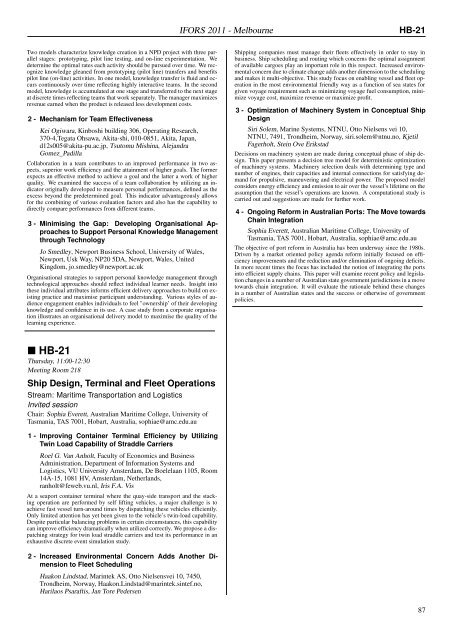Technical Sessions – Monday July 11
Technical Sessions – Monday July 11
Technical Sessions – Monday July 11
You also want an ePaper? Increase the reach of your titles
YUMPU automatically turns print PDFs into web optimized ePapers that Google loves.
Two models characterize knowledge creation in a NPD project with three parallel<br />
stages: prototyping, pilot line testing, and on-line experimentation. We<br />
determine the optimal rates each activity should be pursued over time. We recognize<br />
knowledge gleaned from prototyping (pilot line) transfers and benefits<br />
pilot line (on-line) activities. In one model, knowledge transfer is fluid and occurs<br />
continuously over time reflecting highly interactive teams. In the second<br />
model, knowledge is accumulated at one stage and transferred to the next stage<br />
at discrete times reflecting teams that work separately. The manager maximizes<br />
revenue earned when the product is released less development costs.<br />
2 - Mechanism for Team Effectiveness<br />
Kei Ogiwara, Kinboshi building 306, Operating Research,<br />
370-4,Tegata Ohsawa, Akita-shi, 010-0851, Akita, Japan,<br />
d12s005@akita-pu.ac.jp, Tsutomu Mishina, Alejandra<br />
Gomez_Padilla<br />
Collaboration in a team contributes to an improved performance in two aspects,<br />
superior work efficiency and the attainment of higher goals. The former<br />
expects an effective method to achieve a goal and the latter a work of higher<br />
quality. We examined the success of a team collaboration by utilizing an indicator<br />
originally developed to measure personal performances, defined as the<br />
excess beyond the predetermined goal. This indicator advantageously allows<br />
for the combining of various evaluation factors and also has the capability to<br />
directly compare performances from different teams.<br />
3 - Minimising the Gap: Developing Organisational Approaches<br />
to Support Personal Knowledge Management<br />
through Technology<br />
Jo Smedley, Newport Business School, University of Wales,<br />
Newport, Usk Way, NP20 5DA, Newport, Wales, United<br />
Kingdom, jo.smedley@newport.ac.uk<br />
Organisational strategies to support personal knowledge management through<br />
technological approaches should reflect individual learner needs. Insight into<br />
these individual attributes informs efficient delivery approaches to build on existing<br />
practice and maximise participant understanding. Various styles of audience<br />
engagement enables individuals to feel "ownership’ of their developing<br />
knowledge and confidence in its use. A case study from a corporate organisation<br />
illustrates an organisational delivery model to maximise the quality of the<br />
learning experience.<br />
� HB-21<br />
Thursday, <strong>11</strong>:00-12:30<br />
Meeting Room 218<br />
Ship Design, Terminal and Fleet Operations<br />
Stream: Maritime Transportation and Logistics<br />
Invited session<br />
Chair: Sophia Everett, Australian Maritime College, University of<br />
Tasmania, TAS 7001, Hobart, Australia, sophiae@amc.edu.au<br />
1 - Improving Container Terminal Efficiency by Utilizing<br />
Twin Load Capability of Straddle Carriers<br />
Roel G. Van Anholt, Faculty of Economics and Business<br />
Administration, Department of Information Systems and<br />
Logistics, VU University Amsterdam, De Boelelaan <strong>11</strong>05, Room<br />
14A-15, 1081 HV, Amsterdam, Netherlands,<br />
ranholt@feweb.vu.nl, Iris F.A. Vis<br />
At a seaport container terminal where the quay-side transport and the stacking<br />
operation are performed by self lifting vehicles, a major challenge is to<br />
achieve fast vessel turn-around times by dispatching these vehicles efficiently.<br />
Only limited attention has yet been given to the vehicle’s twin-load capability.<br />
Despite particular balancing problems in certain circumstances, this capability<br />
can improve efficiency dramatically when utilized correctly. We propose a dispatching<br />
strategy for twin load straddle carriers and test its performance in an<br />
exhaustive discrete event simulation study.<br />
2 - Increased Environmental Concern Adds Another Dimension<br />
to Fleet Scheduling<br />
Haakon Lindstad, Marintek AS, Otto Nielsensvei 10, 7450,<br />
Trondheim, Norway, Haakon.Lindstad@marintek.sintef.no,<br />
Harilaos Psaraftis, Jan Tore Pedersen<br />
IFORS 20<strong>11</strong> - Melbourne HB-21<br />
Shipping companies must manage their fleets effectively in order to stay in<br />
business. Ship scheduling and routing which concerns the optimal assignment<br />
of available cargoes play an important role in this respect. Increased environmental<br />
concern due to climate change adds another dimension to the scheduling<br />
and makes it multi-objective. This study focus on enabling vessel and fleet operation<br />
in the most environmental friendly way as a function of sea states for<br />
given voyage requirement such as minimizing voyage fuel consumption, minimize<br />
voyage cost, maximize revenue or maximize profit.<br />
3 - Optimization of Machinery System in Conceptual Ship<br />
Design<br />
Siri Solem, Marine Systems, NTNU, Otto Nielsens vei 10,<br />
NTNU, 7491, Trondheim, Norway, siri.solem@ntnu.no, Kjetil<br />
Fagerholt, Stein Ove Erikstad<br />
Decisions on machinery system are made during conceptual phase of ship design.<br />
This paper presents a decision tree model for deterministic optimization<br />
of machinery systems. Machinery selection deals with determining type and<br />
number of engines, their capacities and internal connections for satisfying demand<br />
for propulsive, maneuvering and electrical power. The proposed model<br />
considers energy efficiency and emission to air over the vessel’s lifetime on the<br />
assumption that the vessel’s operations are known. A computational study is<br />
carried out and suggestions are made for further work.<br />
4 - Ongoing Reform in Australian Ports: The Move towards<br />
Chain Integration<br />
Sophia Everett, Australian Maritime College, University of<br />
Tasmania, TAS 7001, Hobart, Australia, sophiae@amc.edu.au<br />
The objective of port reform in Australia has been underway since the 1980s.<br />
Driven by a market oriented policy agenda reform initially focused on efficiency<br />
improvements and the reduction and/or elimination of ongoing deficits.<br />
In more recent times the focus has included the notion of integrating the ports<br />
into efficient supply chains. This paper will examine recent policy and legislation<br />
changes in a number of Australian state government jurisdictions in a move<br />
towards chain integration. It will evaluate the rationale behind these changes<br />
in a number of Australian states and the success or otherwise of government<br />
policies.<br />
87




